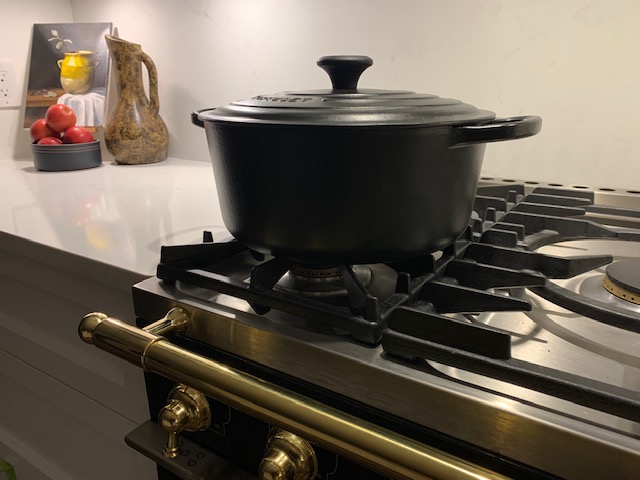When I tell people we lived in a hotel for four months while renovating, the first thing they say is “four months??!?!,” followed by “but what did you cook?”
It’s a fair question. Although we were in a long-stay suite, the kitchen itself consisted of two burners, an apartment-sized fridge and a microwave. And while no oven is an obvious barrier, in some ways the little things were just as challenging.
I’m no professional chef – just ask my family! – but I’ve come to rely on a variety of basic tools to prep, cook and serve food. Carrot peeler, cheese shredder, a couple of decent knives, more than one bowl … all things one takes for granted, it turns out. And while we *could* technically have brought a crock pot, blender or other small appliances with us, we really didn’t want to dig through our boxes in the basement to find them. (I also suspect we didn’t want to admit to ourselves we might actually be in a hotel long enough to need them!)
Still, a girl’s gotta eat (and the kids and hubby get pretty grumpy without food, too) … so we figured it out. If you’re renovating and living with a makeshift kitchen of any sort, I’m sharing my best ideas below in the hopes that they may help you, too. Bon appetit!
- Batch cooking, freezer meals and planned leftovers (otherwise known as: spare yourself the same pain twice).
If you’ve ever spent a Sunday batch cooking or an evening prepping ingredients for multiple meals, your skills will serve you well. As your temporary kitchen is unlikely to be well stocked and spacious (and if it is, score! Move in and don’t renovate 😉), you’ll want to get in and out as quickly as possible. Save yourself the headache of constantly washing your single frying pan by cooking as much as you can of a single item and freezing the extras. I find this works especially well with proteins. Making tacos? Throw some extra ground beef in the pan to set aside for spaghetti later this week and freeze for chili on Monday. Sautéing some chicken breasts? Toss in a few extra and add to salads, wraps, fajitas or quesadillas. You get the idea.
2. Make your ingredients work harder.
One small fridge + four people = planning. You just don’t have the luxury of buying the big tub of sour cream for one recipe, so either buy the smaller one, pick a new recipe or find ways to use the leftovers. If you must have sour cream for your fajitas, grab some seasoning and reinvent the rest as salad dressing, baked potato topping or veggie dip.
On a similar note, pare down pantry ingredients too. Staples like spices can make or break a dish, but do you really have room for 32 jars in your makeshift accommodations? Our family found salt, pepper, cinnamon, paprika, Italian seasoning and chili flakes covered off most recipes during our short stay.
3. Don’t cook.
Seriously. A wrap or sandwich and salad is a respectable meal, I promise.
4. Rethink your options.
Do you have access to a BBQ? If not, can you swing by a friend’s house and borrow theirs? Our hotel had one for guest use, which was helpful for a quick steak, burger or chicken breast – but if you can get your hands on a rotisserie, a whole chicken or beef roast will net you Sunday supper plus plenty of leftovers. Even the smallest bits of chicken with some broth, veggies and leftover pasta can be turned into a simple weeknight soup. And if you don’t have an oven, a BBQ (especially a gas one) can work in much the same way, while a toaster oven is enough to make garlic bread and flatbread pizza, should they be on the menu.
5. Buy prepared ingredients.
If you’re short on kitchen tools, patience, time – or all three – go easy on yourself. Buy the pre–shredded cheese (yes, it tastes awful and it costs more. When you’re in survival mode, something’s gotta give!). Ready-to-eat fruit and veggie platters are a godsend as healthy snacks, sides in school lunches, and starters for stir fries (use the frying pan) and smoothies (if you have a blender). Bagged salads filled with chopped, prewashed veggies often come with dressing, which means one less bottle in the fridge.
Some grocery stores (Longos here in Ontario) have pre-portioned meal kits that just need to be sauteed and come with everything you need. Or try one of the many meal kit delivery services – just be sure to check you have the appliances and any extra ingredients you may need first.
6. Go ready-made.
I’ll admit it: we ate out wayyyyy too much at the hotel. While not good for our waistlines or our wallets, it did occasionally save our sanity. Specialty shops that offer catering are also a good option, and we have an Italian place nearby that will heat a tray of lasagna or chicken parm for you if you call in advance – fantastic when you don’t have an oven. Hot tables at Whole Foods and other grocery stores also have plenty of options, which is helpful if you have one or more picky eaters and less space than ever to accommodate them!
In short, know it can be done. While kitchen renos can make the biggest impact on your home, they are also among the most disruptive. Plan in advance, understand your options and keep the takeout menus handy. Good luck!
Do you have any tips or tricks for living without a kitchen? Please leave them below – I’d love to hear them! And if you’d find my checklists, packing lists and meal ideas helpful, please let me know and I’ll post them under the Resources tab. Happy renovating!

